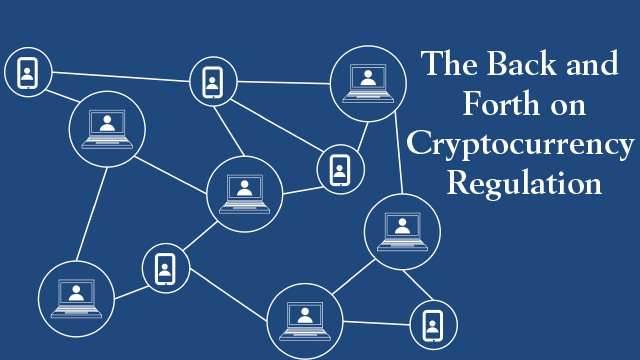
In March 2022, President Biden signed an Executive Order promoting the responsible development of digital assets. The move marks “the first whole-of-government approach to addressing the risks and harnessing the potential benefits of digital assets and their underlying technology.[1]”
It also signals that increased regulation is imminent for a sector that the financial industry has side-eyed like it’s the kid in middle school who just mainlined half a dozen Pixy Stix at lunch and now anything could happen. Best to keep some distance.
That kid has now been invited to sit at the main table, albeit perhaps at the end. But what does increased regulation mean for the cryptocurrency market?
Proponents believe regulation is the catalyst necessary for it to flourish. Those opposed believe regulation will snuff out the industry just as it is gaining mainstream momentum.
Here is an attempted CliffsNotes version of both sides of the argument:
Point: Increased Regulation Could Better Protect Investors
It’s common to read about the crypto market and see the phrase “wild west” somewhere in the article. It’s a cliché at this point. But there’s no denying that the crypto market is flush with scam coins and pump-and-dump schemes aimed to swindle potential investors.
Under the proposed regulations, Initial Coin Offerings (ICOs), the crypto equivalent to Initial Public Offerings (IPOs), would need to meet specific requirements before being offered to the public. As of late, many blockchain companies issuing ICOs have either A) avoided the United States or B) adhered to U.S. regulation. Those that do adhere to government regulation are commonly called Security Token Offerings (STOs). ICOs operate outside of U.S. law, STOs operate within it.
In 2017, an ICO bubble burst, which led to these regulations. Of the 902 tracked ICOs introduced in 2017, 59% either failed or semi-failed by 2018[2]. Investors, it seemed, were willing to dump wheelbarrows full of cash on the lawn of any ole huckster with a crypto in his hand and a song in his heart. They lost to the tune of $277 million.
With more stringent regulation, investors might avoid the ballad of the flim-flam man.
Counter Point: Increased Regulation Could Hamper Innovation
Red tape goes hand in hand with the government. While regulation would hopefully raise the quality of crypto projects available to the public, it could also inhibit the development of potentially lucrative projects from smaller, cash strapped companies that cannot financially sustain the weight of government compliance.
A large part of why cryptocurrency values have skyrocketed is because the ICO model allowed investors to invest in projects earlier than under traditional fundraising and regulatory regimes. New companies with a potentially great idea can raise money quickly, unimpeded by an unfamiliar and complicated set of rules.
Point: The Industry, Specifically Stablecoins, Could Have Large Economic Impact
Stablecoins are coins whose “value is tied to an outside asset, such as the U.S. dollar or gold, to stabilize the price.[3]” Fiat-backed stablecoins like Tether, the largest stablecoin by market cap, are tied to the U.S. dollar and, in a perfect world, would be backed dollar-for-dollar by assets in reserve. That way, if every investor got together and wanted to cash out their coins, they could.
However, that is not reality. Stablecoins are not backed dollar-for-dollar. Most are partially backed by investments, either certificates of deposit or commercial paper (a short-term debt instrument that averages 30 days to maturity). Even after decreasing commercial paper holdings by 21% in Q1 2022[4], Tether is still one of the largest holders of commercial paper in the world and stablecoin operators as a whole may surpass the commercial paper holdings of money market funds within the next few years. Fitch Ratings has cautioned that stablecoins could affect the entire short-term credit market[5] for that reason. If there is a massive sell off, investors might not be able to access their money.
The cryptocurrency market has been prone to violent ups and downs. Exchanges like the New York Stock Exchange (NYSE) and NASDAQ have thresholds where trading is halted if a stock moves too much in the trading day, preventing emotion from driving an asset into the ground. The same safety net could be applied to the crypto market.
Counter Point: Government Interference Could Drive the Industry to Other Countries
Simply put, cryptocurrency companies looking to avoid stringent government rules could take their ball and go home to a more crypto-friendly jurisdiction. Unlike the NYSE or NASDAQ, cryptocurrency operates on a global scale. Miami mayor Francis Suarez has been vocal about trying to turn the city into a hub for crypto innovation.[6]
It worked – blockchain.com plans to move headquarters to Miami and crypto broker/exchange eToro will also have a presence, bringing with them the increased cash and jobs. If the industry chooses to leave the U.S., all those benefits disappear.
Point: Regulation Legitimizes the Industry
At the end of 2021, 16% of Americans had invested in some form of cryptocurrency[7]. That number has increased to over 20% since, but still a far cry from universal adoption. Regulations that attempt to protect Main Street may allow investors to feel more secure investing in a new vehicle.
It could also build up the confidence of institutional investors. Free-thinking individual adults can decide for themselves if the juice is worth the squeeze, but for institutions, it’s more complicated. The risk of capital loss is there, but also the risk of further repercussions due to negligence of fiduciary responsibility. Increased regulation decreases the risk of such repercussions.
Counter Point: Regulation Sucks Out the Industry’s Soul
Decentralization, cutting out the middleman of banks and the government from financial transactions, is what the entire industry is built on. While not as important as the other arguments addressed, it gives individuals freedom to manage their money without the eyes of big brother hovering in the background. Regulations strip the individual of that power, laying it squarely back in the hands of the same institutions it was meant to fight against.
By signing an Executive Order, the White House is sending a pretty clear signal that the government is going to have a hand in cryptocurrency’s future one way or another. It has become too loud to be ignored.
Is it a good decision? Some kids respond well to structure, others lash out even more. Which one will crypto be?
Joe Gallina
 Joe has a degree in Finance from the University of Illinois at Chicago. Afterwards, he worked for Morgan Stanley and Bank of America/Merrill Lynch, obtaining both Series 7 and 66 licenses. At Merrill, he was on the self-directed side of the business, exposing himself to every aspect of the financial services industry.
Joe has a degree in Finance from the University of Illinois at Chicago. Afterwards, he worked for Morgan Stanley and Bank of America/Merrill Lynch, obtaining both Series 7 and 66 licenses. At Merrill, he was on the self-directed side of the business, exposing himself to every aspect of the financial services industry.
[1] https://www.whitehouse.gov/briefing-room/statements-releases/2022/03/09/fact-sheet-president-biden-to-sign-executive-order-on-ensuring-responsible-innovation-in-digital-assets/
[2] https://fortune.com/2018/02/25/cryptocurrency-ico-collapse/
[3] https://www.coindesk.com/learn/what-is-a-stablecoin/
[4] https://www.coindesk.com/business/2022/02/22/tether-slashes-commercial-paper-holdings-by-21/
[5] https://www.fitchratings.com/research/fund-asset-managers/stablecoins-could-pose-new-short-term-credit-market-risks-01-07-2021
[6] https://twitter.com/francissuarez/status/1354488469091975168?lang=en
[7] https://www.pewresearch.org/fact-tank/2021/11/11/16-of-americans-say-they-have-ever-invested-in-traded-or-used-cryptocurrency/
Copyright © 2022 Protinus. All rights reserved.
